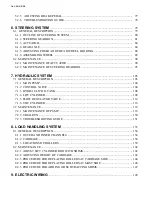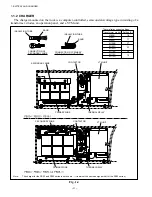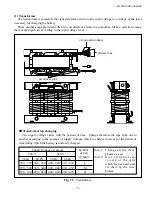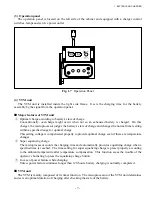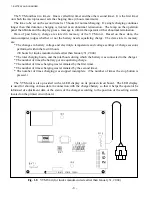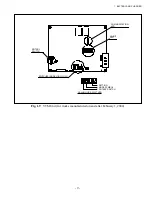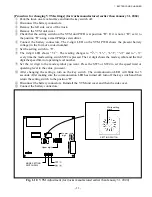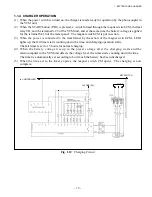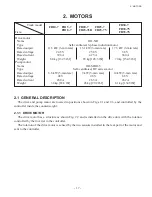
1. BATTERY AND CHARGER
- 3 -
(2) Charging the battery
When discharged, the battery should be recharged as soon as possible. Leaving the battery discharged
for a long time may cause sulfation, which will result in a drop of the battery performance.
If the battery is kept out of service for a long time, it should be thoroughly charged before put in
storage. An additional charge is also required once a month.
Do not leave a fully discharged battery longer than a day as it is. Be sure to recharge it as soon as
possible.
If the amount of discharge is considered to be small, measure the specific gravity of the electrolyte.
If lower than 1.260, recharge the battery.
Equalizing charge is required if the specific gravity varies among the cells by the amount of 0.020 or
larger. Equalizing charge is normally needed between one to four times a month.
If the specific gravity variation is not made smaller by equalizing charge, specific gravity adjustment
will be required.
Giving an equalizing charge more times than necessary will overcharge the battery, and its service
life will be shortened.
For a truck-mounted type charger, a microcomputer determines when an equalizing charge is required
and carries out equalizing charge automatically.
[Cautions on Charging the Battery]
(1) Do not start charging the battery if the electrolyte temperature is higher than 50°C. Leave the
battery for a while until the temperature goes low. Then charge it.
(2) Overdischarge or overcharge raises the electrolyte temperature. While charging the battery, be sure
to keep the battery cover fully open in order to let the generated gas and heat get out.
[Specific Gravity Correction According to Temperature]
The specific gravity of the electrolyte varies as the electrolyte temperature changes. The specific
gravity is generally based on the electrolyte temperature of 20°C. Therefore, if the specific gravity is
measured at the electrolyte temperature if other than 20°C, correct it using the following formula:
S20 = St + 0.0007 (t – 20)
where S20 ............
specific gravity for 20°C
St ...............
specific gravity measured at t
t .................electrolyte temperature measured.
(Discharge rate)
Fig. 1.3
An Example of Specific Gravity Drop
Specific gravity
(at 20°C)
Usable
Alert !
Overdischarge
Voltage (V)
Voltage
(Discharge duration)
Specific gravity
Summary of Contents for FB10-7
Page 2: ......
Page 4: ...No SEB 81BBE...
Page 8: ...No SEB 81BBE...
Page 9: ...No SEB 81BBE Fig 1 Overall Dimensions Unit mm in...
Page 10: ...No SEB 81BBE...
Page 28: ...1 BATTERY AND CHARGER 16 NOTE...
Page 30: ...2 MOTORS 18 DRIVE UNIT Fig 2 1 Drive Motor Installation DRIVE AXLE DRIVE MOTOR...
Page 42: ...3 CONTROL SYSTEM 30 Fig 3 2 Inverter Assembly 1 0 to 2 5 ton Trucks...
Page 43: ...31 3 CONTROL SYSTEM Fig 3 3 Inverter Assembly 3 0 to 3 5 ton Trucks...
Page 44: ...3 CONTROL SYSTEM 32 Fig 3 4 Controller Wiring 1 0 to 2 5 ton Trucks...
Page 45: ...33 3 CONTROL SYSTEM Fig 3 5 Controller Wiring 3 0 to 3 5 ton Trucks...
Page 133: ...7 HYDRAULIC SYSTEM 121 Fig 7 27 Remove the oil seal from the front cover...
Page 160: ...8 LOAD HANDLING SYSTEM 148 NOTE...












